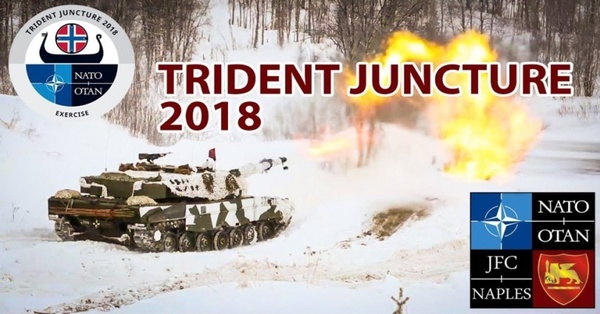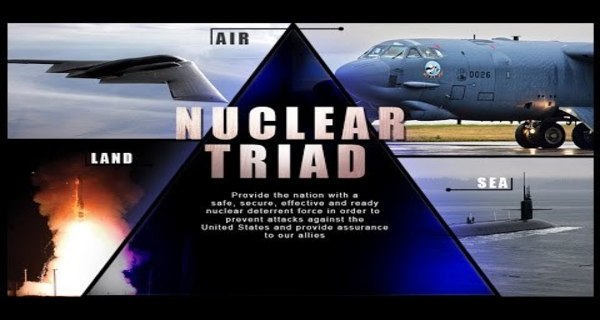November 21, 2018
NATO Was Playing With Fire In 'Trident Juncture 18': Russia's 'Vostok 18' Dwarfed NATO's Exercises, Which Looked To Moscow Like A Sign Of Weakness
- Are these paltry exercises more likely to deter or invite Russian aggression?
By Dr Peter Vincent Pry - All News Pipeline
NATO recently concluded a major military exercise, its largest in years, called Trident Juncture 18, involving 50,000 troops, 10,000 vehicles, 250 aircraft, and 65 ships from 30 countries. Officially neutral Sweden participated, for the first time, as an unofficial NATO ally.
NATO’s military exercise was supposed to deter increasingly aggressive Russia. Even Sweden broke decades-long neutrality to support NATO’s Trident Juncture 18, fearful of Russia annexing oil-rich disputed territories, including the arctic seabed.
Trident Juncture 18 exercised mostly on NATO’s northern flank, in Norway and the other Nordic countries, and the littoral arctic waters. The intended message to Moscow is “hands off!”
But Moscow was not intimidated or deterred.

Indeed, during Trident Juncture 18, Russia waged electronic warfare against Global Positioning Satellites (GPS) supporting NATO forces playing in the military exercise. NATO forces need GPS for navigation and precision strikes.
Bereft of GPS, NATO could lose World War III.
Russia’s electronic attacks on NATO’s GPS during Trident Juncture 18 is a very significant escalation, far more troubling than Russian jets buzzing NATO ships and aircraft, now routine aggression, vociferously protested but passively tolerated by NATO and the U.S.
NATO’s reaction to Russian electronic warfare against Trident Juncture 18? Impotent protests.
What is happening?
The balance of military and nuclear firepower between NATO and Russia is shifting so far in Moscow’s favor that deterrence is failing.
The “Peace Through Strength” formula that for decades averted World War III and enabled the U.S. to win the Cold War peacefully has been neglected for too long. For years, as U.S. and NATO military and nuclear strength declined, leaks have appeared in the “deterrence dam” that has been holding back the flood of a new world war.

Over the years Russian aggression has become increasingly bold. First starting small against Georgia, then annexing Crimea, the long crucifixion of Ukraine, challenging the U.S. in the Middle East, now electronic warfare against NATO.
If strength preserves peace, weakness invites aggression.
The number of main battle tanks (MBTs) is a convenient metric for summarizing the balance of military power shifting against NATO heavily in Russia’s favor:
— Russia has 22,214 MBTs.
— NATO’s Baltic states (Lithuania, Latvia, Estonia) have 3 MBTs.
— NATO’s northern flank comprising Norway (52 MBTs), Finland (239 MBTs), and neutral Sweden (120 MBTs) has altogether 411 MBTs.
— Central NATO, the main invasion route from Eastern Europe to the English Channel, comprising Poland (1,063 MBTs), Germa
ny (250 MBTs), France (200 MBTs), Denmark (57 MBTs), Netherlands (18 MBTs), Belgium (0 MBTs), Luxembourg (0 MBTs), Liechtenstein (0 MBTs) has altogether 1,588 MBTs.
So Russia’s advantage over Central NATO, the European heartland, the conquest of which would decide World War III in the European theater, favors Russia in main battle tanks by 14-to-1. During the height of the Cold War in the 1980s, the USSR’s advantage over European NATO in MBTs was 5-to-1.
Even more importantly, Russia has a virtual monopoly in tactical nuclear weapons, having at least 1,000-2,000 nuclear warheads for battlefield and theater use, whereas U.S. tactical nuclear weapons in NATO have declined to 100-180 obsolete gravity bombs.
U.S. long-range strategic nuclear forces — the Triad of ICBMs, missile submarines, and bombers — is really the last line of defense deterring Russian aggression. The Triad deters China, North Korea, and Iran too.

All over the world relatively small numbers of U.S. troops are deployed or occasionally appear in problem areas serving as “nuclear tripwires” to deter aggression, not by their inherent strength, but by reminding the bad guys to fear the U.S. Triad.
For example, 5,000 U.S. troops in Poland and the Baltic states, or a U.S. aircraft carrier transiting the Taiwan Straits, are weak deterrents themselves, grossly inadequate to defend against the military might of Russia or China. But the U.S. troops and carriers are backed by the nuclear Triad, which has kept the peace and deterred World War III, so far.
The Triad is in trouble. U.S. ICBMs, submarines, bombers, and their nuclear weapons are decades old, designed for deterrence during a different era, and now dangerously obsolete.
Democrats, having captured the House in recent elections, promise to oppose President Trump’s plans to modernize the nuclear Triad. They oppose too President Trump’s plans to rebuild the strength, long neglected by President Obama, of the U.S. Army, Air Force, Navy, and Marines.
Perhaps NATO needs to re-think exercises like Trident Juncture 18 and others until the U.S. can rebuild the strength and credibility of its nuclear and conventional forces.
Trident Juncture 18 was intended as a show of strength, but looked to Moscow like weakness. Just in September, Russia conducted an enormous military exercise, Vostok 18, mobilizing 300,000 troops, 36,000 tanks, and other vehicles, 1,000 aircraft, and 80 ships.
Vostok 18 dwarfed Trident Juncture 18. NATO has not conducted a really big exercise, like Reforger (that mobilized 115,000 troops), since 1987.
Most Americans are unaware that NATO and the U.S. regularly conduct military exercises around the periphery of Russia extending the “nuclear tripwire” into non-NATO states, like Rapid Trident 18 (2,200 U.S. troops) in Ukraine and Saber Strike 18 (1,170 U.S. troops) in Georgia.
Are these paltry exercises more likely to deter or invite Russian aggression?
This story was originally published here. Dr. Peter Vincent Pry is executive director of the Task Force on National and Homeland Security. He served on the Congressional EMP Commission as chief of staff, the Congressional Strategic Posture Commission, the House Armed Services Committee, and the CIA. He is author of "Blackout Wars." For more of his reports, Go Here Now.
The views and opinions expressed in this article are those of the author and do not necessarily align with those of ANP.
ANP Needs Your Help. With digital media revenue spiraling downward, especially hitting those in Independent Media, it has become apparent that traditional advertising simply isn't going to fully cover the costs and expenses for many smaller independent websites.
Any extra readers may be able to spare for donations is greatly appreciated.
One time donations or monthly, via Paypal or Credit Card:

Or https://www.paypal.me/AllNewsPipeLine
Donate monthly from $1 up by becoming an ANP Patron.


|
|



